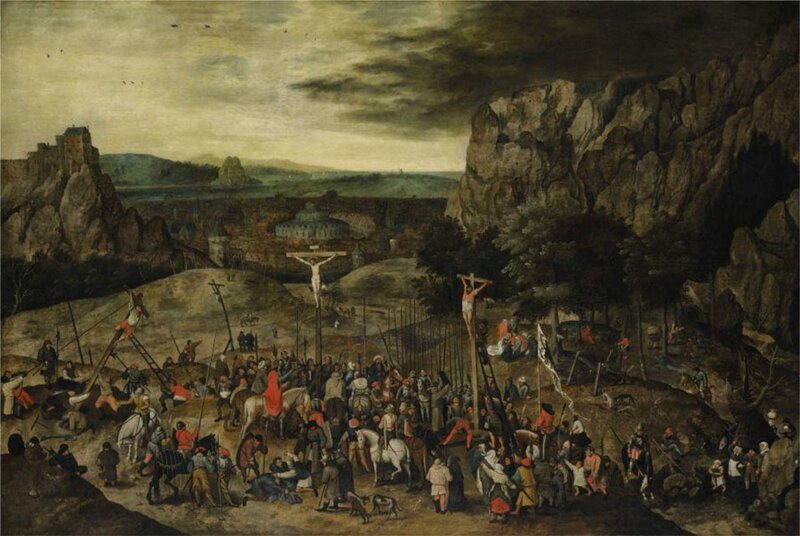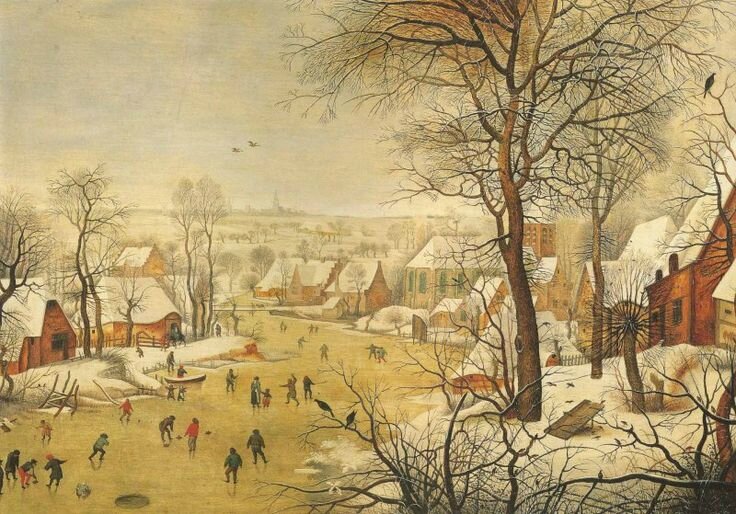Sotheby's to present Flemish Old Master paintings from the Coppée collection
Pieter Brueghel the Younger, Calvary, 1615, oil on oak panel, 99.9 by 147.5 cm.; 39⅜ by 58 in. (est. £ 3-4 million). Photo Sotheby's.
LONDON.- This summer, Sotheby’s London will present a remarkable group of Flemish Old Master paintings from the Coppée Collection. Assembled by the Belgian industrialist Evence Coppée III (1882-1945) in the 1920s, this outstanding collection comprised almost exclusively 16th and 17th century works, with an emphasis on the works of Pieter Brueghel the Younger (1564-1637/8) and the Brueghel family. Of the paintings by Pieter Brueghel the Younger that Baron Coppée collected, three of the best will feature in the sale, including an imposing landscape with the Crucifixion, an Outdoor Wedding Dance, recognised as one of the most popular works in the artist’s oeuvre, and a splendidly evocative Winter Landscape. The selection also encompasses impressive paintings resulting from a collaboration between Jan Brueghel the Younger and artists such as Frans Francken the Younger and Hendrik van Balen the Elder, as well as works from the North Netherlandish School and the School of Northern France.
Passed on by direct descent from Baron Coppée, these works have not appeared on the market for almost a century. They will be auctioned as part of a group of 19 paintings from the Coppée Collection in Sotheby’s London Old Master sales on 9 and 10 July 2014.
Talking about the forthcoming sale, George Gordon, Sotheby’s Co-Chairman, Old Master Paintings, Worldwide commented: “The Coppée collection was one of the first and finest collections of paintings by Pieter Brueghel the Younger and his family. Three paintings by the artist spearhead the group of Flemish paintings in our July sale, and each one is outstanding. The Bird Trap was one of Brueghel's most popular compositions in his own day and remains so now. It is a beautifully preserved crystalline evocation of a Flemish village on a freezing cold day, painted at a time when winter was just starting to be appreciated for its beauty and not merely feared. The Outdoor Wedding Dance, presents an entirely different facet of Brueghel's art: an intense composition of swirling inebriated peasant wedding guests dancing to the raucous Flemish bagpipes, the bride looking bemused in the centre of it all. The greatest of the three Brueghels however is the moving, monumental depiction of Calvary from 1615, a rare work that is in the spirit of his father's paintings of fifty years before, but reveals an unambiguously stark view of a cruel world, its vegetation parched, its massed rocky outcrops overbearingly threatening”.
Pieter Brueghel the Younger who had been overlooked by previous generations of scholars and collectors until after the First World War occupied a special place in Baron Coppée’s heart. This fascination was perhaps not only due to the collector’s keen interest in Flemish Old Masters but also to the resonance of Pieter Brueghel the Younger’s works with the traumatic memories of the Great War. The three compositions to be sold in July are illustrative of the artist’s powerful depictions of the tragedy of the human condition, seen through his sympathetic eyes. They also count among the rarest and most popular works in the Flemish painter’s oeuvre. .
Calvary
In this huge and deeply moving painting Pieter Brueghel sets out the scene of Christ’s crucifixion as narrated by the Gospels. Realised in 1615, this oil on oak panel ranks among the rarest of all Pieter Brueghel the Younger’s compositions. It is one of only two signed works which deal with the subject of the Crucifixion. Only four certainly autograph versions of this precise composition are known, and Calvary is by common consent the finest (est. £3-4 million/ €3,650,000-4,860,000/ $5,020,000-6,690,000).
Pieter Brueghel the Younger, Calvary, 1615, oil on oak panel, 99.9 by 147.5 cm.; 39⅜ by 58 in. (est. £ 3-4 million). Photo Sotheby's
The Outdoor Wedding Dance
The Outdoor Wedding Dance belongs to a series of pictures painted by the Brueghels which depict different episodes during a wedding day - a tradition founded by Pieter Bruegel the Elder whose Wedding Banquet of 1568 (Vienna, Kunsthistorisches Museum) is undoubtedly the most famous example. The present work has long been recognised as one of the most popular works in Pieter Brueghel the Younger’s oeuvre and Georges Marlier, the great scholar of Flemish art, went so far as to describe this painting as “one of the most popular of all subjects in Flemish painting at the beginning of the seventeenth century”1. With over sixty known versions on the subject, the Coppée version - most likely executed in the 1610s - is one of the finest to have survived, and remains in a remarkable state of preservation (est. £1-1.5 million/ €1,220,000-1,830,000/ $1,680,000-2,510,000).
Pieter Brueghel the Younger, The Outdoor Wedding Dance. Oil on oak panel, 41.6 by 62 cm.; 16⅜ by 24⅜ in. (est. £1-1.5 million). Photo Sotheby's.
Winter landscape with a bird trap
This painting is not only one of the best loved of all the inventions of the Brueghel dynasty, but in its beautiful depiction of a winter’s day, also one of the most enduring images in Western art. It owes its fame to its extraordinary evocation of the atmosphere of a cold winter’s day. It is one of only eight panels which have the distinction of being both signed and dated. Painted in 1626, it is the latest in date of those so far known (est. £1-1.5 million/ € 1,220,000-1,830,000/ $1,680,000-2,510,000).
Pieter Brueghel the Younger, Winter landscape with a bird trap, 1626. Oil on oak panel, 40.4 by 57.2 cm.; 15⅞ by 22. in. (est. £1-1.5 million). Photo: Sotheby's.
BARON EVENCE COPPÉE III (1882-1945)
Baron Evence Coppée III was born in 1882 into a family of Belgian industrialists. His grandfather had invented a revolutionary coke-producing furnace, and his father had expanded the coke manufacturing and carbo-chemical businesses, building factories as far afield as Donetsk in Russia, where the young Nikita Khruschev worked in one of them. Baron Coppée continued the expansion of Evence Coppée et Cie, acquiring Société métallurgique d’Espérance-Longdoz, subsequently the largest Belgian producer of sheet metal, in 1920. He also diversified the family’s interests to include, inter alia, banking, chemicals and power generation.
His marriage in 1919 to Marguérite de Woot de Trixhe, perhaps combined with the return of Europe to peace following the First World War, seems to have been the catalyst that triggered his collecting fervour. In the 1920s Baron Coppée assembled a collection including mostly Flemish 16th and 17th century paintings. The collection was almost complete by the time he moved into the house that he conceived and had built on the Avenue des Nations (now Avenue Franklin Roosevelt) in Brussels in 1930, and very few paintings were acquired subsequently. The house became the Japanese Ambassador’s Residence in the 1990s, and the longstanding connection of the Coppée family with Japan led in 1995 to an exhibition of the entire collection in the Tobu Museum, Tokyo.
Baron Coppée collected works by Les Primitifs Flamands, but also, and in particular, works by Pieter Brueghel the Younger and his family. His most fertile years as a collector coincided with the first serious studies of the works of the sons of Pieter Bruegel the Elder, culminating with the exhibition mounted by Peter de Boer in Amsterdam of De Helsche en Fluwelen Brueghel in 1935, to which he was a generous lender. From the outset the Baron bought paintings directly at auction, but he also acquired many works from Galerie De Heuvel in Brussels, and it seems likely that Arthur de Heuvel, one of the first dealers to specialise in works by the Brueghel family, was a mentor.

/https%3A%2F%2Fprofilepics.canalblog.com%2Fprofilepics%2F1%2F0%2F100183.jpg)
/https%3A%2F%2Fstorage.canalblog.com%2F03%2F02%2F119589%2F96711876_o.jpg)
/https%3A%2F%2Fstorage.canalblog.com%2F11%2F31%2F119589%2F94773502_o.jpg)
/https%3A%2F%2Fstorage.canalblog.com%2F20%2F83%2F119589%2F94772815_o.jpg)
/https%3A%2F%2Fstorage.canalblog.com%2F26%2F72%2F119589%2F75604929_o.jpg)
/https%3A%2F%2Fstorage.canalblog.com%2F59%2F60%2F119589%2F26458628_o.jpg)






/http%3A%2F%2Fstorage.canalblog.com%2F94%2F09%2F119589%2F128556743_o.jpg)
/http%3A%2F%2Fstorage.canalblog.com%2F00%2F82%2F119589%2F122298365_o.jpg)
/http%3A%2F%2Fstorage.canalblog.com%2F68%2F17%2F119589%2F122146900_o.jpg)
/http%3A%2F%2Fstorage.canalblog.com%2F89%2F15%2F119589%2F112611888_o.jpg)